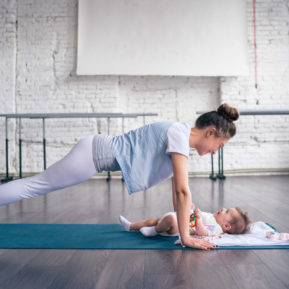Unfortunately there is still a lot of fear, confusion and myths out there about pregnancy exercise so hopefully this post can help dispel those myths and give you more confidence.
How often can you exercise when pregnant?
This is a question lots of mums-to-be ask me. My advice is, if you have fallen pregnant and aren’t already exercising regularly begin with 15 minutes of activity three times a week then increase this gradually to 30 minutes, 5 times a week. If you are already exercising you can continue with your regular activities so long as you feel able to and have your doctors clearance.
Often women are worried about how to exercise safely during pregnancy however the benefits really are endless when it comes to your physical and mental health.
Remember that every woman and each pregnancy is different so you should decide what feels right for you. I would always recommend speaking to your Doctor or Midwife before embarking on any exercise during your pregnancy.
If you're deemed high risk or have any medical conditions please ensure you have clearance before continuing or starting any exercise. Contact sport activities or those where you risk falling or having impact to your bump should be avoided throughout your pregnancy. These include skiing, rugby, kick boxing, horse riding or martial arts.
Here are five top tips to follow for exercise during pregnancy
2. It's safe to continue with cardiovascular exercises such as running, cycling, circuit training however you do not want to push yourself to the point of exhaustion. You shouldn’t be so out of breath you are unable to speak whilst exercising. Perform the talk test, if you are unable to speak at any point this is a sign you need to scale back. You can reduce the intensity by taking longer rests between exercises and taking the modified options of exercises.
3. Make sure you include pelvic floor exercises daily, ideally performing them three times a day. You want to ensure you practise both quick squeeze and releases (x10) and longer 10 second holds (x10) each time. I would recommend downloading the Squeezy app for helpful timers and reminders. If you have any pelvic floor dysfunction such as pain/leaking/heaviness it is worth seeing a women's health physiotherapist during your 2nd or 3rd trimester as they can assist with this.
4. Work to 70/80% of what you did before you were pregnant in terms of weight and the number of reps for example if you used to squat 15kg for 20 reps perhaps drop down to 10kg for 15 reps. It’s likely by your 3rd trimester you will need to make further modifications. When exercising be sure to focus on good posture and solid technique over the weight and number of reps.
5. Allocate some time each week to stretch and relax and focus on breath. Not only will this help your mind but your body too. During pregnancy we want to maintain strength to support the postural changes but also have flexibility and mobility ready for the challenges of labour and postnatal recovery. In particular during pregnancy working on hip opening poses and releases for your back will be really beneficial. Regular mobility exercises like the ones we perform in Yoga and Pilates can help decrease symptoms of Pelvic Girdle Pain PGP) and ease back pain.
Remember to be kind to yourself and do what feels good for you and your body.
For other expert tips and advice on staying healthy during pregnancy, check out our wellbeing section.
Sign up today for unlimited access:
- Book appointments
- Expert advice & tips
- Premium videos & audio
- Curated parenting newsletters
- Chat with your bloss community
- Discounts & competitions
- Special events




Leave a Rating / Review
You must be logged in to post a comment.